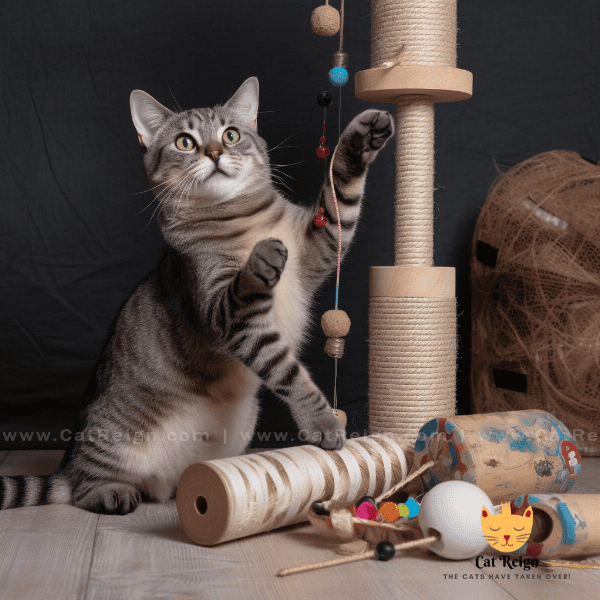Table of Contents
- Understanding Why Your Cat Scratches at the Door
- The Negative Effects of Cat Scratching on Doors
- Tips for Preventing Cat Scratching at the Door
- Redirecting Your Cat’s Scratching Behavior
- The Importance of Providing Adequate Scratching Surfaces
- Addressing Separation Anxiety in Cats
- When to Seek Professional Help for Your Cat’s Scratching Behavior
- Alternatives to Traditional Doors for Cat-Friendly Homes
- Understanding the Benefits of Positive Reinforcement Training for Cats
- Maintaining a Happy and Healthy Relationship with Your Feline Friend
Understanding Why Your Cat Scratches at the Door
Cats are known for their scratching behavior. They scratch to sharpen their claws, mark their territory, stretch their muscles, and relieve stress. However, when your feline friend starts scratching at your door, it can be frustrating and disruptive.
Instinctual Behaviors
Scratching is an instinctual behavior in cats. It is a way for them to mark their territory and communicate with other cats. When they scratch at the door, they may be trying to tell other cats that this area is their territory. Additionally, scratching also helps cats shed their outer claw sheaths, which allows their claws to stay sharp and healthy.
Environmental Factors
In some cases, your cat may scratch at the door due to environmental factors. For example, if your cat is bored or anxious, they may scratch at the door to release pent-up energy or alleviate stress. Additionally, if your cat is kept indoors for long periods, they may scratch at the door as a way to express their desire to explore and play outside.
Separation Anxiety
Another reason why your cat may scratch at the door is due to separation anxiety. Cats are social animals, and they crave attention and affection from their owners. If they feel lonely or neglected, they may scratch at the door to get your attention and be close to you.
Understanding why your cat scratches at the door is the first step in preventing this behavior. By identifying the root cause, you can take steps to redirect their behavior and provide a more suitable outlet for their scratching needs. In the next section, we will discuss the negative effects of Cat scratching on doors and why it is important to address this behavior.
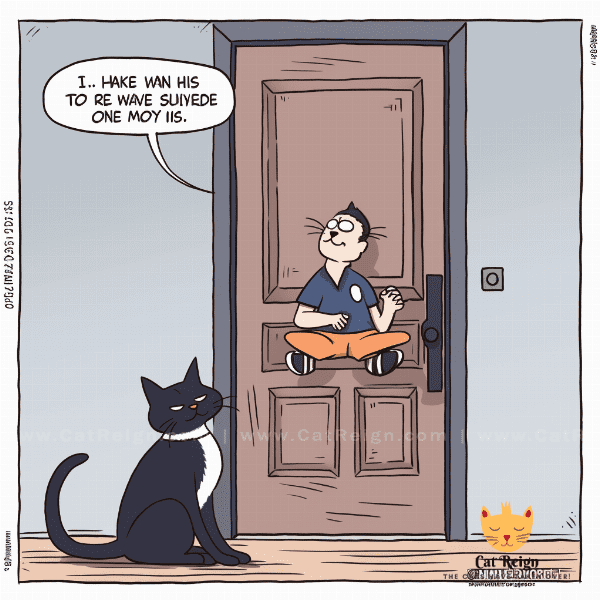
The Negative Effects of Cat Scratching on Doors
While scratching is a natural behavior for cats, it can cause significant damage to your doors. This behavior can result in unsightly scratches, gouges, and even holes in your doors. Not only can this damage be expensive to repair, but it can also decrease the overall value and appearance of your home.
Structural Damage
Cat scratching can also cause structural damage to your doors. The constant scratching and clawing can weaken the door’s surface, making it more susceptible to cracks and breakage. Over time, this damage can compromise the integrity of the door and require a complete replacement.
Noise Pollution
In addition to physical damage, cat scratching can also cause noise pollution. The constant sound of scratching can be disruptive and irritating, especially if you are trying to concentrate or relax. This noise pollution can also disturb your neighbors, especially if you live in an apartment or shared living space.
Safety Concerns
Finally, cat scratching can pose safety concerns. If your cat scratches through the door, they may create a hole or opening that could allow other animals or pests to enter your home. Additionally, the sharp edges of the damaged door can cause injury to both humans and pets.
It is important to address cat scratching behavior to prevent the negative effects it can have on your home and your cat’s wellbeing. In the next section, we will discuss tips for preventing cat scratching at the door.
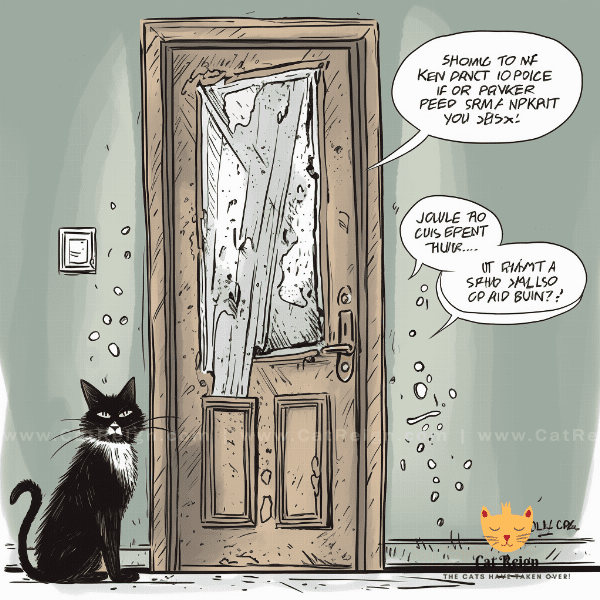
Tips for Preventing Cat Scratching at the Door
Preventing cat scratching at the door requires a combination of understanding your cat’s behavior and providing suitable alternatives for them to express their natural scratching tendencies.
Provide Adequate Scratching Surfaces
One of the most effective ways to prevent cat scratching at the door is to provide your cat with adequate scratching surfaces. This can include scratching posts, cardboard scratchers, and sisal mats. By providing these surfaces, you can redirect your cat’s scratching behavior to a more appropriate location.
Use Deterrents
Another option is to use deterrents to prevent your cat from scratching at the door. These can include double-sided tape, aluminum foil, or citrus-scented sprays. Place these deterrents around the door frame to discourage your cat from scratching in that area.
Address Environmental Factors
If your cat is scratching at the door due to environmental factors, it is important to address these issues. Ensure that your cat has plenty of toys, playtime, and mental stimulation. Consider providing a window perch or outdoor enclosure to give your cat the opportunity to explore and play.
Positive Reinforcement
Positive reinforcement is a powerful tool in addressing cat scratching behavior. Reward your cat for using their scratching surfaces with treats, praise, and playtime. This will reinforce the behavior you want to see and help your cat understand that scratching in the appropriate location is rewarding.
.

Redirecting Your Cat’s Scratching Behavior
Redirecting your cat’s scratching behavior is a crucial step in preventing damage to your doors and other surfaces. Here are some tips for redirecting your cat’s scratching behavior.
Provide a Suitable Alternative
First and foremost, it is essential to provide your cat with a suitable alternative to scratching at the door. This can be a scratching post or a similar surface that satisfies their natural scratching needs. Place the scratching post near the door where your cat typically scratches.
Make the Door Less Appealing
Another strategy is to make the door less appealing to your cat. Cover the door with double-sided tape or aluminum foil to make it uncomfortable for your cat to scratch. You can also try placing a citrus-scented air freshener near the door, as cats typically dislike the smell of citrus.
Create a Positive Association
Encouraging your cat to use their scratching post is key to redirecting their behavior. You can do this by placing treats and toys near the scratching post or by playing with your cat in the vicinity of the post. This creates a positive association with the post and encourages your cat to use it instead of scratching the door.
Use Positive Reinforcement
Positive reinforcement is a powerful tool in redirecting your cat’s scratching behavior. Whenever you catch your cat using their scratching post, provide praise and treats. This reinforces the behavior you want to see and encourages your cat to continue using the post.
Redirecting your cat’s scratching behavior requires patience and persistence. By providing a suitable alternative, making the door less appealing, creating a positive association, and using positive reinforcement, you can redirect your cat’s behavior and maintain a damage-free home.
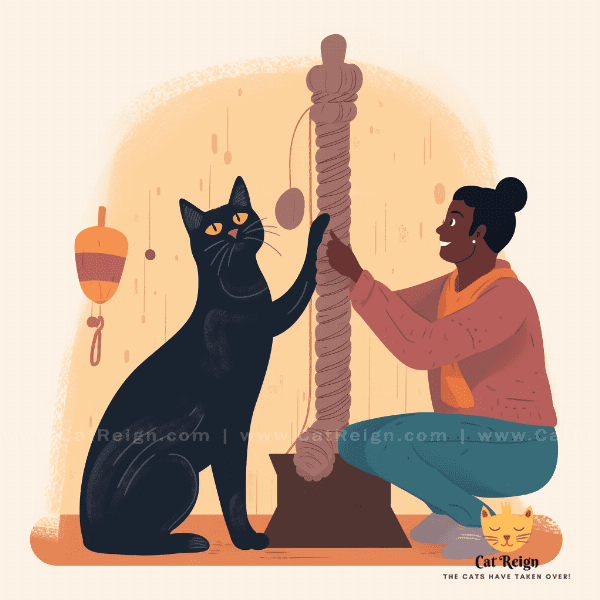
The Importance of Providing Adequate Scratching Surfaces
Providing your cat with adequate scratching surfaces is essential for their physical and mental wellbeing. Here’s why.
Promotes Healthy Scratching Behavior
Scratching is a natural behavior for cats, and it is crucial to their physical and mental health. Scratching helps to keep their claws sharp and healthy, stretch their muscles, and alleviate stress. By providing adequate scratching surfaces, you can promote healthy scratching behavior and prevent damage to your home.
Reduces Stress and Anxiety
Cats can become stressed and anxious if they do not have an appropriate outlet for their scratching behavior. This can lead to destructive behaviors, including scratching at the door. By providing a suitable scratching surface, you can reduce your cat’s stress and anxiety and promote a more relaxed and contented state.
Helps to Maintain Territory
Scratching is also a way for cats to mark their territory. By providing multiple scratching surfaces throughout your home, you can help your cat maintain their territory and reduce the likelihood of destructive behavior, such as scratching at the door.
Provides Mental Stimulation
Finally, providing your cat with adequate scratching surfaces can provide much-needed mental stimulation. Cats are curious and intelligent animals, and they need opportunities to explore and interact with their environment. A scratching post or similar surface can provide your cat with hours of entertainment and mental stimulation.
In summary, providing your cat with adequate scratching surfaces is essential for their physical and mental wellbeing. It promotes healthy scratching behavior, reduces stress and anxiety, helps to maintain territory, and provides mental stimulation. By providing multiple scratching surfaces throughout your home, you can prevent destructive behavior, such as scratching at the door, and maintain a happy and healthy home for you and your feline friend.

Addressing Separation Anxiety in Cats
Separation anxiety is a common issue for cats and can lead to destructive behaviors, including scratching at the door. Here are some strategies for addressing separation anxiety in cats.
Gradual Departures and Returns
One way to address separation anxiety is to gradually acclimate your cat to your departures and returns. Start by leaving your cat alone for short periods of time and gradually increasing the length of time you are away. When you return, greet your cat calmly and give them attention, praise, and treats.
Provide Comfortable Environment
Ensure that your cat has a comfortable environment in which to stay while you are away. Provide a cozy bed, access to water and litter box, and toys to keep them entertained. You can also leave a piece of clothing with your scent on it to provide comfort and reassurance.
Reduce Stressful Triggers
Identify and reduce any stressful triggers that may be contributing to your cat’s separation anxiety. This can include loud noises, other pets, or changes in routine. By minimizing these triggers, you can help reduce your cat’s anxiety and prevent destructive behaviors, such as scratching at the door.
Seek Professional Help
Addressing separation anxiety in cats requires patience and consistency. By gradually acclimating your cat to your departures and returns, providing a comfortable environment, reducing stressful triggers, and seeking professional help when needed, you can help reduce your cat’s anxiety and prevent destructive behaviors, such as scratching at the door.

When to Seek Professional Help for Your Cat’s Scratching Behavior
While scratching is a natural behavior for cats, persistent scratching at the door can be a sign of an underlying issue. Here are some signs that it may be time to seek professional help for your cat’s scratching behavior.
Damage to Your Home
If your cat’s scratching behavior is causing significant damage to your home, such as scratches, gouges, or holes in your doors or walls, it may be time to seek professional help. This can include a certified animal behaviorist or your veterinarian, who can identify the root cause of the behavior and provide effective solutions to prevent further damage.
Inconsistent or Aggressive Behavior
If your cat’s scratching behavior is accompanied by inconsistent or aggressive behavior, it is important to seek professional help. This can include hissing, growling, biting, or scratching at people or other pets in the home. A certified animal behaviorist can help identify the underlying cause of the behavior and provide effective solutions to address it.
Excessive Scratching
If your cat’s scratching behavior is excessive, it may be time to seek professional help. This can include scratching for extended periods, scratching at all hours of the day and night, or scratching despite having adequate scratching surfaces. A certified animal behaviorist can help identify the root cause of the behavior and provide effective solutions to redirect your cat’s scratching behavior.
Health Issues
Finally, if your cat’s scratching behavior is accompanied by other health issues, such as lethargy, loss of appetite, or weight loss, it is important to seek professional help. Your veterinarian can help identify any underlying health issues and provide appropriate treatment.
In summary, persistent scratching at the door can be a sign of an underlying issue in your cat. If your cat’s scratching behavior is causing significant damage to your home, is accompanied by inconsistent or aggressive behavior, is excessive, or is accompanied by other health issues, it is important to seek professional help. A certified animal behaviorist or your veterinarian can help identify the root cause of the behavior and provide effective solutions to prevent further damage and maintain a happy and healthy home for you and your feline friend.
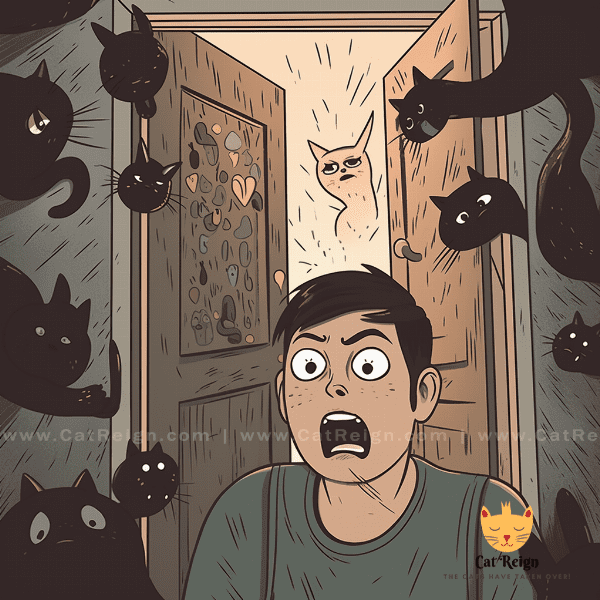
Alternatives to Traditional Doors for Cat-Friendly Homes
If your cat’s scratching behavior is persistent, and you are finding it challenging to redirect their behavior, there are alternatives to traditional doors that may be more cat-friendly.
Dutch Doors
Dutch doors are another option for cat-friendly homes. They allow you to keep the top half of the door open, providing ventilation and natural light, while keeping your cat safely indoors. Dutch doors also provide a barrier that can help prevent damage to your main door.
Cat Doors
If you have a fenced-in backyard or live in a more rural area, a cat door may be a viable option. Cat doors allow your cat to come and go as they please, giving them the freedom to explore and play outside while still having access to the safety and comfort of your home.
Barn Doors
Barn doors are a stylish and functional alternative to traditional doors. They slide open and closed, making them perfect for cat-friendly homes. Barn doors also provide a barrier that can help prevent damage to your main door, while still allowing your cat to see and hear what’s going on outside.
In summary, if your cat’s scratching behavior is persistent, and you are finding it challenging to redirect their behavior, there are alternatives to traditional doors that may be more cat-friendly. Screen doors, Dutch doors, cat doors, and barn doors are all viable options that provide a barrier to prevent damage to your main door while still allowing your cat to see and hear what’s going on outside.
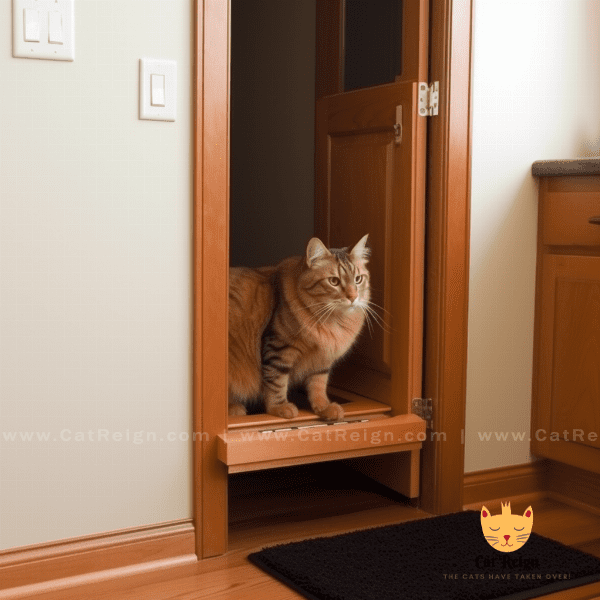
Understanding the Benefits of Positive Reinforcement Training for Cats
Positive reinforcement training is a powerful tool for modifying your cat’s behavior. Here are some of the benefits of positive reinforcement training for cats.
Encourages Positive Behavior
Positive reinforcement training encourages positive behavior by rewarding your cat for engaging in desirable behaviors. For example, if you want to teach your cat to use a scratching post instead of scratching at the door, you can reward them with treats and praise every time they use the post. This encourages your cat to engage in positive behavior and reduces the likelihood of destructive behavior.
Strengthens the Bond Between You and Your Cat
Positive reinforcement training can also strengthen the bond between you and your cat. By spending time training your cat and providing treats and praise, you are building a positive association between yourself and your cat. This can lead to a closer and more affectionate relationship between you and your feline friend.
Improves Your Cat’s Overall Behavior
Positive reinforcement training can have a positive impact on your cat’s overall behavior. By encouraging positive behavior and reducing undesirable behavior, you can create a more harmonious home environment. This can lead to a happier and healthier cat, as well as a happier and less stressed household.
Builds Confidence and Self-Esteem
Positive reinforcement training can also help build your cat’s confidence and self-esteem. By rewarding your cat for engaging in positive behavior, you are helping them feel more confident in their abilities. This can lead to a more outgoing and sociable cat, which can be beneficial for their mental and physical health.
In summary, positive reinforcement training is a powerful tool for modifying your cat’s behavior. It encourages positive behavior, strengthens the bond between you and your cat, improves your cat’s overall behavior, and builds confidence and self-esteem. By incorporating positive reinforcement training into your cat’s routine, you can create a more harmonious home environment and maintain a happy and healthy relationship with your feline friend.

Maintaining a Happy and Healthy Relationship with Your Feline Friend
Maintaining a happy and healthy relationship with your feline friend is crucial for their physical and mental wellbeing. Here are some tips for fostering a positive relationship with your cat.
Spend Quality Time Together
Spending quality time with your cat is essential for building a strong bond. This can include playing with your cat, grooming them, or simply snuggling with them on the couch. Regular interaction with your cat can help them feel loved and cared for, which is crucial for their overall wellbeing.
Provide a Stimulating Environment
Cats are curious animals that need mental stimulation to thrive. Providing your cat with a stimulating environment can help prevent destructive behaviors, such as scratching at the door, and promote overall wellbeing. This can include providing toys, scratching posts, and access to windows or perches where they can observe their surroundings.
Offer Healthy Food and Water
Providing your cat with healthy food and water is essential for their physical health. Ensure that your cat has access to fresh, clean water and a well-balanced diet that meets their nutritional needs. This can help prevent health issues and promote overall wellbeing.
Practice Positive Reinforcement Training
Positive reinforcement training is a powerful tool for modifying your cat’s behavior and strengthening your bond. By rewarding your cat for engaging in positive behaviors, such as using a scratching post, you can encourage desirable behavior and promote a more harmonious home environment.
Seek Regular Veterinary Care
Regular veterinary care is essential for maintaining your cat’s health and wellbeing. Ensure that your cat receives regular check-ups and vaccinations, and seek veterinary care promptly if you notice any changes in their behavior or health.
In summary, maintaining a happy and healthy relationship with your feline friend is crucial for their physical and mental wellbeing. By spending quality time together, providing a stimulating environment, offering healthy food and water, practicing positive reinforcement training, and seeking regular veterinary care, you can promote a happy and healthy life for your beloved cat.




